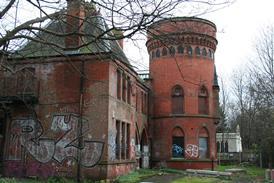Britain’s leaders are educated at Oxford – where they never meet an architecture student, writes Ben Flatman

For decades now, architects have been bemoaning their own waning influence as well as the ruling elite’s institutional lack of interest in design. Many of BD’s opinion pieces and comments echo this view, pointing to architects’ diminished status and our seeming inability to influence wider government policy on the built environment. We often blame the profession itself, and the perceived failings of an ineffectual RIBA. But what if one of the reasons for this professional impotence lay in the peculiarities of Britain’s higher education system and the failure of one of its top universities to teach architecture?
If you’re in a position of power in government, the civil service or business in the UK, there’s a significant chance that you went to Oxbridge. And in politics in particular, Oxford dominates. Eight of the current British cabinet were at Oxford; “just” four from Cambridge. When it comes to the top job, it’s not even a two-horse race. The last time there was a Cambridge-educated occupant of 10 Downing Street was in 1937. Since then we’ve had 17 prime ministers, of whom 10 were Oxford graduates. Only one of the other seven even went to university.
So far, so shocking (or perhaps predictable). If we look across the Atlantic, many recent US presidents have also been drawn from the equally elitist, but slightly larger, pool of top American universities. George W Bush and Barack Obama both attended Harvard. Bill Clinton studied at Yale (and Oxford, of course).
But what distinguishes Oxford from many of its US equivalents, as well as Cambridge, is that it doesn’t teach architecture. It is an anomaly among the world’s leading universities in not treating design or architecture as serious, and essential, academic disciplines. By contrast, Harvard has been teaching architecture since 1876 and the origins of Cambridge’s school go back to the early 20th century.
There have been sporadic attempts to bring the study of architecture closer to the academic mainstream in Oxford. In the 19th century Ruskin delivered a series of lectures on architecture as the university’s first Slade Professor of Fine Art. And in the 1920s, there was a short-lived campaign to introduce a taught degree course. Rebuffed by the university, that effort led to the founding of the Oxford School of Architecture in 1927, which eventually became part of the polytechnic and a respected institution in its own right.
One of the great ironies of the university not teaching architecture itself is that its colleges have been among some of Britain’s greatest architectural patrons. Powell and Moya’s Staircases 16, 17 and 18 at Brasenose and ABK’s wonderfully futuristic student bar at Keble still stand out as among the best of 20th-century British modernism. And a handful of Oxford graduates have even gone on to become notable architects themselves – Wren among them.
To the extent that architecture gets attention at Oxford today, it’s mostly within the Faculty of History. Professor William Whyte teaches a long-standing course on the English Baroque and is an expert in 19th- and early 20th-century ecclesiastical and university architecture. When I spoke to him recently he bemoaned the fact that “Oxford graduates emerge architecturally illiterate”. He also highlighted one of Oxford’s more unique strengths – the way in which the collegiate system requires students from a wide variety of disciplines to live and study alongside each other. “The idea of Oxford is that you learn from other students and it’s a great shame we are not able to learn from architects,” he said. The implication of what Professor Whyte says is that those who go on to run the country know little or nothing about architecture.
This situation has left architecture largely on the margins of the university which produces nearly all our prime ministers and a significant proportion of the most influential players in countless other areas of our national life. Given Oxford’s cultural dominance, it’s no wonder that architecture is given a low priority by government or British society at large. It also means that architects themselves are significantly disadvantaged in terms of accessing the informal power networks that stem from studying alongside the country’s future ruling elite. We might not like it but, because of the way in which the UK works, lack of access to Oxford very often means architects are not at the top table when the key decisions are being made.
Cambridge did briefly fulfil the role of providing a bridge between architecture and the governing class during the 1960s, when Leslie Martin occupied a particularly influential position as unofficial architect to the British state. At that time, when half the profession worked in the public sector, Martin was able to place his acolytes in key positions across the country – “a king-maker doling out jobs” as Whyte puts it. But the status and influence of the Cambridge school has since waned and, in any case, the university’s graduates do not hold the same grip over government as those from Oxford.
One response to this hegemony of the “architecturally illiterate” might be to call for a radical shake-up of how the country is run, breaking Oxford graduates’ monopoly on power. This is perhaps just the kind of reorganisation many of those who voted for Brexit would like to see – a kick up the backside of the establishment. But they’d better note that Michael Gove and Boris Johnson, the two leading figures in the official Leave campaign, both went to Oxford. The prevalence of Oxford graduates within all political parties means our oldest university has always hedged its bets and shows no signs of loosening its grip on government any time soon.
So a more realistic and achievable solution might be for Oxford to start doing what it hasn’t done before in nearly a thousand years – start its own school of architecture. This wouldn’t be without challenges. Oxford evolves incredibly slowly. The dons strongly resisted the introduction of medicine as a taught course in the 19th century. And characteristic of the university’s glacial pace of change is that it only started teaching art history at undergraduate level in 2004, so radical a step was it deemed to be.
If any wealthy benefactor wants to leave a lasting architectural legacy to the university and the country, there is a far better option than endowing a new laboratory or lecture theatre. Why not bequeath a new architecture faculty? Almost by default it would immediately be among the most popular schools in the world.
More importantly though, it would bring consideration of the built environment into the heart of the British establishment. As Professor Whyte said, “It would be a wonderful thing if Oxford taught architecture.” The life of the university would be immeasurably enriched. We might also get a future government that cared about architecture, and a profession able to exert influence for all of our benefit.
















24 Readers' comments